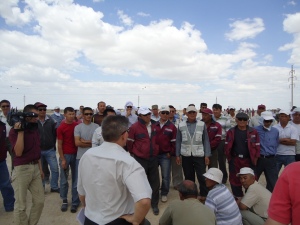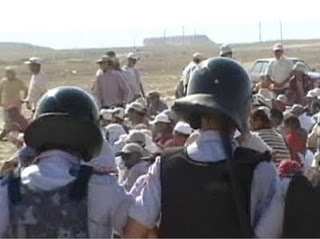Security forces opened fire on protesters at Zhanaozen, Kazakhstan, who were demanding better pay and conditions in the country’s oil fields, on Friday 17 December. Eleven people were killed and more than 70 wounded, according to the government. Kazakh opposition media and Russian reporters, working in the face of attempts by the authorities to impose a news blackout, say the number of victims may have been much higher.
In spite of the brutality of the massacre, on 18-19 December the protests spread. There was a big demonstration in nearby Aktau and clashes between police and protesters at Shepte. (See a good report by Reuters here.)
The Zhanaozen massacre is a turning-point in two important ways. First, it is the first mass murder of protesting workers in any of the post-Soviet republics. (There was a larger massacre in Andizhan, Uzbekistan, in 2005, when security forces shot dead of an unknown number of protesters, probably several hundred: the victims there were not strikers but a more heterogenous crowd.) Second, the Zhanaozen massacre amounts to the Kazakh state’s response to workers’ insistent demands that they share some of the wealth produced by the country’s oil boom – which is in turn a result of the relentless search by big international capital for new sources of oil, that is so central to its economy.
Zhanaozen and London
The main square at Zhanaozen, in the western Kazakhstan oilfield, has been occupied by protesters for six months. When police tried to break up their encampment before, in July, it is reported that 60 of them poured petrol over themselves and threatened to set light to it. In December, the police did the killing.
The Zhanaozen protests were part of a campaign by oil workers and their families for better living standards that began in May this year and swelled to a strike by about 16,000 workers in three oil companies in June. The campaign has persisted through the summer until now, despite several assassinations,several arrests and thousands of sackings. (For more background, see this blog post by Platform, and this one by Nadejda Atayeva.)
The Kazakh oil workers seem to have started out with a desperate, collective decision that they would no longer tolerate humiliating poverty, in a country whose elite has been vastly enriched by the oil boom of the last decade. Their demands include the right to organise independent unions, as well as for specific improvements in pay and working conditions.
On the picket line in the summer. Photo from Nadejda Atayeva’s blog
These motivations are in some respects different from those of the Occupy protesters in London, New York and elsewhere, who direct their anger at the unjust character of the financial system. But there is much more in common. The Zhanaozen oil workers, like the Occupy protesters, took over public space – the town square. Their anger boiled over when the authorities tried to reclaim it with a stage and decorations to mark the 20th anniversary of the establishment of the Kazakh state after the break-up of the Soviet Union.
There are obvious connections, too, between the targets of protest: the City of London, and New York, are key conduits via which the Kazakh state and its oil companies are financed. (Some details here.) Kazmunaigaz Exploration & Production, a subsidiary of Kazakhstan’s national state-controlled oil company, is listed on the London Stock Exchange. That deal was managed by Credit Suisse and Morgan Stanley banks.
People in the British political establishment have, with amazing vulgarity, offered themselves as spin doctors and PR agents for the Kazakh government. Tony Blair, the former prime minister, has signed a consultancy deal with Astana worth several million pounds (see here). Richard Evans, former chairman of British Aerospace, has now become chairman of Samruk-Kazyna, a state-owned holding company that controls a big chunk of the Kazakh economy.
For these reasons, it is good to know that a demonstration in support of Kazakh oil workers is planned in London on Wednesday. Details here.
Desperately seeking oil supplies
It’s worth looking at the Zhanaozen massacre, and the oil field strike wave that preceded it – which was by far the largest labour protest movement in the two decades of post-Soviet Kazakhstan’s history – in wider perspective.
The break-up of the Soviet Union in 1991 was seen by the international oil companies (IOCs) and the elites of the big oil-consuming economies – in the first place, the USA and Europe – as holding great promise. The Soviet Union was one half of a duopoly that dominated oil production; the other half was Saudi Arabia. The USSR was not part of OPEC, the producers’ cartel led by the Saudi kingdom. And once the USSR broke up into 15 separate republics, the consuming nations and the IOCs went hunting in those with the largest reserves – Kazakhstan, Azerbaijan and of course Russia.
From the IOCs’ standpoint, Kazakhstan and Azerbaijan offered the prize of reserves that they could book as their property (important for their stock exchange valuations). Russia did too, but (especially since 2000) its government, having curbed the power of Russia’s own oil companies, became tougher to negotiate with.
The big production projects that the IOCs tied up with Kazakhstan in the 1990s were the Tengiz field (where Chevron, ExxonMobil and Lukoil work with Kazmunaigaz) and Karachaganak (being developed by a joint venture between BG Group of the UK, ENI of Italy, Chevron and Lukoil). Arguments between Kazakhstan and the IOCs about the development of a third big field, Kashagan, continue.
Strategically, the western elites deemed the Caspian region (primarily Azerbaijan and Kazakhstan for oil, and Turkmenistan for natural gas) as vital. The chaos of the early 1990s produced a steep fall in oil output from these nations, and from Russia – but by the 2000s, they were being seen as the best source of growth of non-OPEC supplies. And then came China’s rapid economic expansion. Over the last ten years it has joined the competition for central Asian oil, and made great progress.
The search for oil is central to capitalism’s endless drive to expand. That is probably why, after the 2008 financial crisis pushed the largest capitalist economies into the worst recession since the 1930s, the price of oil fell sharply for a few months, but then rose to above $100/barrel, and has stayed there. In other words, even after the recession, the market’s expectations are that ever more money will have to be invested, in ever more distant and difficult oil fields. The front line in this war of conquest of natural resources has moved to the Canadian tar sands, triggering Canada’s departure from the Kyoto treaty … and to the Caspian, bringing death to the streets of Zhanaozen.
The relentless search for new oil resources is often mistakenly portrayed as a primarily environmental question – that is, a matter of people producing and consuming oil to the environment’s detriment. But I think it should be understood as a social process. Capitalist accumulation requires the search to be stepped up constantly. In Kazakhstan, the damage done to society is obvious. The elite has focused the economy on the production of oil, which is mostly exported. The elite benefits. The gap between that elite and the oil-producing communities in western Kazakhstan gets wider and wider. In the end, the elite’s priorities are enforced by the security forces’ guns.
The exported oil is burned in the big consumer countries, often wastefully, contributing its small share to the global warming crisis. Under capitalism, both production and consumption of oil are just parts of the process by which economies generate profit. The damage is both to humans and by humans, because they are locked in an economy whose direction is determined by capitalism’s inhuman, anti-human logic. The movement past capitalism, and past oil, is one that embraces the aspirations both of Kazakhstan’s oil communities and of the Occupy protests. GL.


